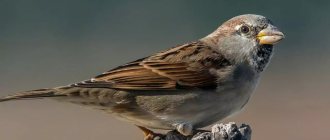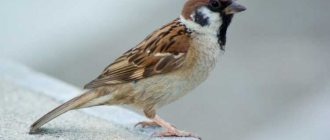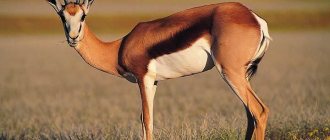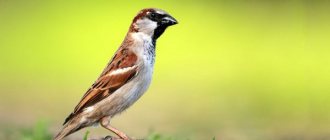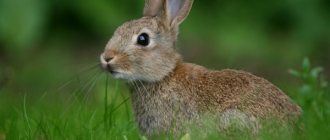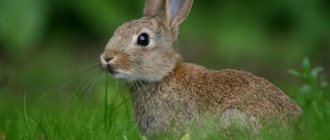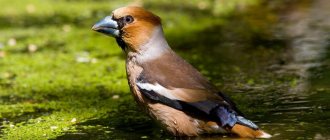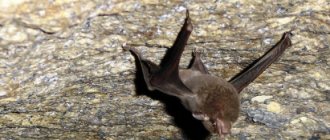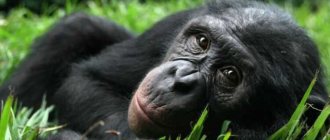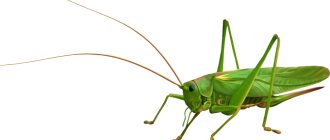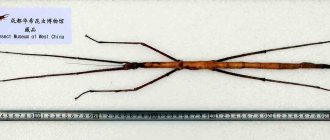The ladybug is an extremely common insect, most often having a bright spotted color. The ladybug family (Coccinellidae) includes a huge number of species - about 8000 (approximately 360 genera). Most of them are beneficial to humans because they feed on certain pests.
Ladybug, appearance of a typical representative of the family
What does it look like?
The insect has a rounded, egg-shaped body, flattened at the bottom and convex at the top.
Juveniles most often have a bright red color (but other colors also exist).
On the back of the ladybug there are black dots with a diameter of 1–2 mm. However, their number varies and depends on the type of insect.
The body size ranges from 4 mm to 1 cm (maximum).
There are also flexible multi-segmented antennae and hard, expressive elytra. Interesting fact! When flying, an insect makes an average of 85 beats per second.
Fourteen-spotted ladybird (Propylea quatuordecimpunctata)
Widely distributed in the Old World. The elytra are yellow (or black), with a black (or yellow) pattern.
Fourteen-spotted ladybird
There are more than 100 combinations of colors and pattern shapes. Due to external differences, some subspecies were originally classified as separate species. The background color ranges from cream to yellow and light orange, but never red. They typically have 14 black spots on their elytra, which often merge into an anchor-like shape. Sometimes they merge to such an extent that the main color almost completely disappears with the exception of 12 light yellow spots. The antennae and legs are yellowish-brown.
Fourteen-spotted ladybird
Feeds on aphids, whiteflies, coccids, as well as the larvae and eggs of some beetles and butterflies
Fourteen-spotted ladybird
Origin of the species and population
The ladybug is an arthropod insect from the order Coleoptera. This bug received its scientific name (Coccinellidae) due to the scarlet coloring of its body. There are many varieties of ladybugs, and the entire family contains more than 4,000 species.
Over the past couple of decades, the population of ladybugs has decreased amid active control of aphids. And, as a result, the little red bugs had nothing to eat.
The situation became very sad when scientists made one irreparable mistake (of course, guided by good intentions). In order to maintain the population, millions of artificially raised individuals were released into the natural environment, which, due to existing gene mutations, dramatically changed their diet, choosing their own relatives as food. This resulted in the death of a huge number of beneficial bugs, so in all European countries their populations have noticeably decreased.
Where does this name come from?
The question of why the insect got its name still remains open. There are several versions:
- The arthropod was called “cow” either for its ability to secrete so-called “milk”, or for spots on its body reminiscent of the colors of many breeds of cows;
- The insect was awarded the epithet “ladybug” for helping people preserve crops; in addition, despite the fact that in nature it is a rather dangerous predator, among people the ladybug is valued for its harmlessness and gentle disposition.
There are other options for the origin of the name. For example, the ancient Slavs associated a bright bug with the goddess of fertility.
Varieties, their names, descriptions and photos
Below is a description of what ladybugs are, a detailed description of the most interesting varieties; You will also be able to see their photos, including close-up photos.
Point-to-point
The body length of the two-spot ladybug reaches about 5 mm. The color is dark red with two parallel black dots on the back (hence the characteristic name). The body has an oblong-oval, moderately convex shape.
The head of light-colored individuals is black, with two large irregularly shaped spots (near the eyes). Dark bugs have a completely black head.
Seven-point
The seven-spotted ladybird is one of the most common species in Europe . The body size is about 8 mm. The color is red, and there are 3 black spots on the sides. The seventh spot is located near the head.
Twelve-point
The twelve-spotted ladybird reaches 6 mm in length. It has a red or pink color. There are 6 black dots on each elytra. The insect lives primarily in North America and feeds on pollen from agricultural plants.
Thirteen-point
The thirteen-spotted ladybird has 13 spots on its surface. Color - red-brown or brick. In this case, some spots may merge with each other. The insect is common in Europe, Asia and North America.
Asian
The Asian ladybird or Harlequin reaches a length of 7 mm. It is either yellow-black or black-orange in color . The insect lives in Asia and feeds on aphids.
Note! This species is characterized by the greatest gluttony, therefore it is specially cultivated in Europe and North America to combat agricultural pests.
Ocellated
The ocellated ladybug is considered one of the largest and reaches a length of approximately 1 cm. The color is red or yellow. In this case, each of the spots is surrounded by a lighter halo. There are 20 such “eyes” on the back of the insect.
Pointless
The spotless ladybird is one of the rarest species , characterized by a complete absence of dark spots. The body of the insect is red or brown in color and covered with barely noticeable fibers. The insect reaches several millimeters in length.
Blue
The blue cow is the most unusual representative of this family. A distinctive feature of the insect is the blue color of the elytra with a characteristic metallic sheen. Dark spots on the back are absent (or simply not visible, because they merge with the dark blue color).
It lives in the eastern part of Australia, as well as in New Zealand. The insect feeds mainly on aphids. The body size does not exceed 4 mm.
Pine ladybug (four-spotted) (lat. Harmonia quadripunctata)
This species is the most common type of large ladybird found on coniferous trees, usually Scots pine. Color of elytra: brown, pink, salmon, yellow. Pattern color: black spots and cream stripes in two forms:
Pine ladybug (four-spotted) (lat. Harmonia quadripunctata)
- "16-spotted": 16 black spots in a 1-3-3-1 pattern on each elytra (most common) and
- "4-spotted": 4 black spots on the outer side of the elytra.
Number of points: 4-20 (usually 16). Pronotum: white with 5-9 black spots with a characteristic pattern. Leg color: brown. Other features: it often lies head down on pine buds, where it is very well camouflaged. Feeds on aphids.
Pine ladybug (four-spotted) (lat. Harmonia quadripunctata)
They overwinter in clusters in the bark of coniferous trees.
What kind of lifestyle do they lead?
Regardless of the species, ladybugs lead a solitary life, showing a bright image of individualists . These insects are collected only for procreation. They also form flocks to fly to warm places (because they don’t like the cold).
But there are also sedentary individuals who huddle together during the winter in some secluded, abandoned place (under fallen bark, tree foliage, etc.). With the onset of warmth, they leave their shelter, scattering across meadows and clearings.
Why is it called that?
Here are some of the versions of the origin of the name:
- In ancient times, the insect was personified with the thunder god - Perun.
The ladybug was credited with the ability to influence the weather and was perceived as a link between mortal people and the gods. - Catholics considered her a messenger of the Mother of God.
- The British associated the insect with the Virgin Mary.
But the most optimal and plausible version of why the bug was named so is that the insect secretes a poisonous white liquid (the so-called “milk”) to scare away predators. And “God’s”, probably because it helped fight aphids and other agricultural pests and did not harm humans.
Interesting fact! The Slavs considered the ladybug to be a direct messenger of the sun. Therefore, it was impossible to drive her away, much less kill her. Otherwise, you could “turn away” your luck.
Nutrition
These peaceful creatures for humans are very dangerous for living organisms of their size and type and are voracious predators. But even with their carnivory they bring considerable benefits to humans. After all, those whom they eat are known as malicious pests and parasites.
What do ladybugs eat ? They destroy hordes of aphids (an adult can eat about a hundred of them in a day), eat other insects, their eggs, as well as caterpillars, pupae and even butterflies.
Therefore, in order to save farmland, ladybugs are deliberately bred and dropped from airplanes in large numbers. If they lack food, they happily turn to the eggs of a well-known pest of potato plantings - the Colorado potato beetle.
But there are species of these insects whose diet includes only plant foods: flowers, leaves, pollen, and in some cases, plant fruits and mushrooms. They really sometimes become a big problem, causing damage to fields and crops growing on them.
However, such species are more common in southern Asia. In Russia they exist (for example, alfalfa and pointless ladybugs), but they are not common.
Some classify this insect as a pest only because they confuse it with others. For example, there is an insect that looks like a ladybug . This is epilyakhna. It eats potato tops and harms tomatoes, pumpkins, corn, and cucumbers.
There are pests similar to the ladybug, epilyachna
It is also called the potato ladybug. It differs from the described insects in the dull colors of its outfit, the abundance of spots (there are as many as 28 of them), and upon closer examination you can see thin whitish hairs on the body.
What does the bright warning color mean?
It is no coincidence that the ladybug is endowed with a bright color - it helps to survive in harsh natural conditions and scares away various enemies (predatory insects, birds, etc.). This is also a kind of mimicry, like a chameleon’s ability to adapt to the color of its environment (foliage, trees, sand, etc.) for the purpose of self-preservation.
And bright colors are warning signals for the wild world, indicating the inedibility and, possibly, toxicity of a potential victim. There is even a theory in the scientific world that goes something like this: “ The brighter the color of an insect, the less likely it is to be attacked by a predator .” Therefore, the red coloring looks something like a stop sign for all sorts of enemies. However, with age, the scarlet color fades.
Where do they live?
Ladybugs can be found in almost every corner of the world, with the exception of northern latitudes (Antarctica and other polar regions).
The active period of their life activity occurs in the spring-summer period, when there are a lot of aphids and other small insects that red bugs can feast on in abundance.
As for specific habitats, they feel most comfortable in open areas with lush vegetation (lawns, clearings, forest edges, etc.). Others prefer to live in reed thickets (along water bodies). The optimal temperature for insect life should be at least +10 degrees.
How and where do they winter?
As mentioned earlier, with the onset of autumn, some insects cluster in large groups, each of which numbers up to a million individuals. Initially, they look for secluded places (wood, dry leaves, stones, abandoned buildings, etc.), then they move there and wait for the arrival of spring. Other species, on the contrary, prefer to leave their usual habitats for the winter, flying like birds to the southern corners of the planet.
Attention! If you find “sleepy colonies” of insects, you should not disturb them. If they are somehow in the way (for example, they are in a barn, bathhouse, or some other place that will be used in the future for household needs), you need to carefully put them in a jar and move them to a comfortable place where they can safely spend the winter .
How do they reproduce, are born and develop?
Insects reach sexual maturity at approximately 3–6 months of life (depending on the species).
Their mating season begins with the arrival of spring. The female produces a characteristic odor, thanks to which the future chosen one finds her. Next, mating occurs, and the female lays eggs (most often near colonies of parasites to provide food for the offspring).
The eggs are oval in shape with slightly tapered ends. Color - yellow-orange. In one clutch, the female manages to lay about 400 eggs . After 1–2 weeks, the larvae are born.
The ladybug goes through the following stages of development:
- larva remains in this state for 1–2 months.
- The pupa attaches itself to the grass and spends 7–10 days in this position. It is during this period that the necessary parts of the body are formed.
- An adult lives from several months to 1–2 years.
External features of a ladybug
The body is oval or round-oval, less often oblong. Strongly convex on top, almost hemispherical or ovoid, the lower part of the body is almost flat. Body length is from 0.8 to 18 mm, usually 4-7 mm. The smallest are representatives of the genus Carinodulinka. The genus Megalocaria has the largest size. In most cases, the insect's body is naked, in some species it is covered with small, inconspicuous hairs.
The head is short and small. The eyes are large. The length of the antennae can vary significantly, but they always consist of 8-11 segments. They have a club-shaped shape. The mouthparts are gnawing type. The upper jaws are clearly visible and sickle-shaped.
The mesothorax is movably connected to the prothorax and immobile to the metathorax. The pronotum is usually widened at the base and rounded, wider than the head, the mesothorax in most species is straight, and the metathorax is wide and almost square. The elytra of representatives of this family are rounded. The wings are wide and long. It should be noted that in some species of ladybugs they are reduced. The limbs are moderately long, well developed, covered with short dense hairs.
Most often, these beetles are very noticeable due to their bright coloring, which is similar to the warning coloration of poisonous insects. It can appear in various combinations of red, yellow, brown, white and black, usually with black spots on a mostly light background. As the insect ages, its color fades. Sexual dimorphism is very weakly expressed. In rare cases, a female can be distinguished from a male by the pattern on the pronotum.
Stages of ladybug development: imago, larva, pupa
Ladybug larvae have an elongated body and 3 pairs of well-developed legs. Their coloration and body shape can vary greatly depending on the species. The minimum length of the larvae is 0.5 mm, and the maximum is 18 mm. Typically, young larvae are quite pale in color; as the insect develops, it becomes brighter.
All about the benefits and harm
- The benefit of ladybugs is that they eat large quantities of parasites - pests of agricultural land. Therefore, they are specially bred at enterprises for the appropriate purpose.
- Herbivorous species of these insects can cause harm to humans , causing irreparable damage to agricultural crops (in particular potatoes, cucumbers, tomatoes and sugar beets). But most of these species live exclusively in tropical countries.
Main orders of insects
The insect class includes 5 main orders:
| Units | Type of development | Number of pairs of wings and their features | Type of mouthparts | Representatives |
| Orthoptera | With incomplete transformation | Two, the first pair is tight | Gnawing | Locusts, grasshoppers, crickets |
| Coleoptera, or beetles | With a complete transformation | Two, hard wings and elytra | Gnawing | May beetle, Colorado potato beetle, ladybug, burying beetles |
| Lepidoptera (butterflies) | With a complete transformation | Two, wings covered with scales | Sucking | Cabbage white, hawthorn, silkworms |
| Diptera | With a complete transformation | One | Stabbing, licking | Flies, mosquitoes, horseflies |
| Hymenoptera | With a complete transformation | Two, the first one is bigger than the second one | Gnawing, gnawing-licking | Bees, wasps, bumblebees |
Interesting Facts
Here are some interesting facts about ladybugs:
- In ancient times, people were able to predict the weather with the help of red bugs.
So, if a cow quickly flew away from the palm, this foreshadowed bright and sunny weather in the future. If, on the contrary, the insect did not fly away anywhere and continued to sit on the hand, rain and thunderstorms were expected.
- In many countries, ladybugs are considered a symbol of good luck, so they should never be harmed. Otherwise, you can bring trouble on yourself and your family.
- Scientists still cannot solve the mystery of how ladybugs return each time after migrating to the same places where they lived in the warm season.
- At the beginning of the 19th century, in many European countries and the United States, specially trained people tracked the wintering sites of ladybugs and collected them in bags. In the spring, insects were released into the fields.
In this video, interesting facts about ladybugs will be presented in a fascinating and knowledgeable way, which may surprise someone and help to better “understand” these little red bugs.
Test on the topic: “Insects”
Time limit: 0
Navigation (job numbers only)
0 out of 30 tasks completed
Questions:
- 1
- 2
- 3
- 4
- 5
- 6
- 7
- 8
- 9
- 10
- 11
- 12
- 13
- 14
- 15
- 16
- 17
- 18
- 19
- 20
- 21
- 22
- 23
- 24
- 25
- 26
- 27
- 28
- 29
- 30
Information
The verification test task includes questions with one or more correct answers.
You have already taken the test before. You can't start it again.
The test is loading...
You must log in or register in order to begin the test.
You must complete the following tests to start this one:
results
Correct answers: 0 out of 30
Your time:
Time is over
You scored 0 out of 0 points (0)
| Average result |
| Your result |
Categories
- No category 0%
maximum of 38 points
| Place | Name | Recorded | Points | Result |
| Table is loading | ||||
| No data | ||||
Your result has been recorded in the leaderboard Loading
- 1
- 2
- 3
- 4
- 5
- 6
- 7
- 8
- 9
- 10
- 11
- 12
- 13
- 14
- 15
- 16
- 17
- 18
- 19
- 20
- 21
- 22
- 23
- 24
- 25
- 26
- 27
- 28
- 29
- 30
- With answer
- With a viewing mark
- Task 1 of 30
1.
Branch of zoology that studies insects
Right
Wrong
- Task 2 of 30
2.
Insect body parts
Right
Wrong
- Task 3 of 30
3.
Number of legs in insects
Right
Wrong
- Task 4 of 30
4.
The body of insects is covered
Right
Wrong
- Task 5 of 30
5.
The movement of insects is ensured
Right
Wrong
- Task 6 of 30
6.
Insect wings vary
Right
Wrong
- Task 7 of 30
7.
The abdomen of insects includes
Right
Wrong
- Task 8 of 30
8.
Type of fly mouthparts
Right
Wrong
- Task 9 of 30
9.
Type of bee mouthparts
Right
Wrong
- Task 10 of 30
10.
Type of butterfly mouthparts
Right
Wrong
- Task 11 of 30
11.
Type of mouthparts of the cockchafer
Right
Wrong
- Task 12 of 30
12.
Features of the circulatory system of insects
Right
Wrong
- Task 13 of 30
13.
Insects breathe using
Right
Wrong
- Task 14 of 30
14.
Excretory organs of insects
Right
Wrong
- Task 15 of 30
15.
A formation covering the external organs of an insect. Accumulates harmful and beneficial substances.
Right
Wrong
- Task 16 of 30
16.
Type of limbs of a mole cricket
Right
Wrong
- Task 17 of 30
17.
Locust limb type
Right
Wrong
- Task 18 of 30
18.
Has a chewing stomach
Right
Wrong
- Task 19 of 30
19.
Insect sense organs
Right
Wrong
- Task 20 of 30
20.
Incomplete metamorphosis of insects is represented by stages:
Right
Wrong
- Task 21 of 30
21.
The complete metamorphosis of insects is represented by stages:
Right
Wrong
- Task 22 of 30
22.
Insects with complete metamorphosis
Right
Wrong
- Task 23 of 30
23.
Insects with incomplete metamorphosis
Right
Wrong
- Task 24 of 30
24.
Representatives of Orthoptera
Right
Wrong
- Task 25 of 30
25.
Representatives of Lepidoptera
Right
Wrong
- Task 26 of 30
26.
The order Diptera belongs to
Right
Wrong
- Task 27 of 30
27.
Hymenoptera include
Right
Wrong
- Task 28 of 30
28.
Cluster of wingless larvae
Right
Wrong
- Task 29 of 30
29.
Ectoparasites include
Right
Wrong
- Task 30 of 30
Security
The ladybug is already listed in the Red Book in many countries, including Russia.
If this insect completely disappears, humanity will face an imbalance in nature and the active proliferation of dangerous pests, which will have to be destroyed chemically.
Therefore, today ladybugs are successfully bred in laboratory conditions , and then released into the fields. But in order to maintain balance, it is necessary to abandon the chemical destruction of aphids and direct general efforts to improve the ecological situation of the environment.
Ladybugs are amazing creatures of nature that bring great benefits to people (with the exception of herbivorous species). They protect crops from various kinds of parasites, thereby preserving the harvest and allowing humanity to do without chemicals. However, in recent years the number of these beneficial insects has noticeably decreased, so they are listed in the Red Book and attempts are being made to restore the population artificially.
The meaning of insects
Insects play a very important role both in nature and in human life.
Dung beetles that live in the soil are able to improve its structure by enriching it with humus. Ants, ladybugs, wasps and other insects are capable of destroying a large number of agricultural pests.
People use honey bees very successfully in their economic activities. Bees collect flower nectar and at the same time pollinate plants.
Hymenoptera insects: bees, ants, termites and some wasps live in families, forming entire colonies. Such insects are called social.
Bees are representatives of social insects
In the colonies one can distinguish: females and queens, males, soldiers, scouts, nannies, working individuals, etc.
Man has adapted to breeding silkworms, from whose cocoon threads natural silk is made.
Silkworm
Some representatives of insects are capable of very quickly destroying the trunks of dead trees, animal corpses, manure, etc. This helps to fulfill a sanitary role and maintain the circulation of substances in nature.
In some countries, insects (such as locusts) are eaten
A wide variety of insect pests are found in nature: the Colorado potato beetle, the pest bug, the beet weevil, the fall armyworm, locusts, many types of aphids, etc. Huge damage to forestry is caused by bark beetles, longhorned beetles, gypsy and pine silkworms.
Mosquitoes, horse flies, mosquitoes, lice and fleas, being blood-sucking insects, carry a number of dangerous diseases (plague, encephalitis, malaria, etc.).
Ectoparasites (louse and flea)
Cockroaches and some types of ants create everyday problems for humans.
Khrushchev, grinder beetles, leather beetles, and clothes moths damage human clothing and food.
Some types of insects are poisonous, and their bites are very painful for humans.
The Asian locust causes enormous damage to agriculture, destroying hundreds and even thousands of hectares of cultivated plants. The number of locusts depends on their form: gregarious and non-gregarious. The gregarious forms form numerous flocks capable of flying long distances.
The non-gregarious form of locusts does not form large swarms and lives sedentary.
One female locust forms a generation capable of destroying food reserves that would be enough for a whole cow or two rams.
Insects are the largest group of animals, distributed in all corners of the globe. They lead a primarily terrestrial lifestyle, crawling on land and flying through the air. Their main differences: they have 3 pairs of legs; the body is clearly divided into head, chest and abdomen; many have 2 pairs of wings.
Insect development occurs in two ways: incomplete transformation (egg - larva - imago) and complete transformation (egg - larva -> pupa - imago).
